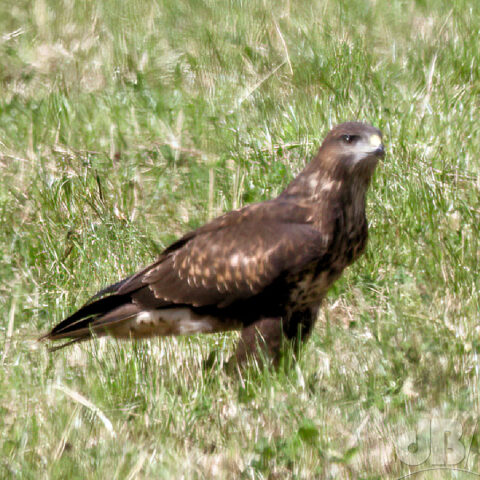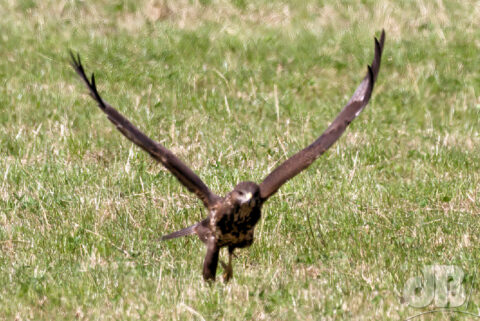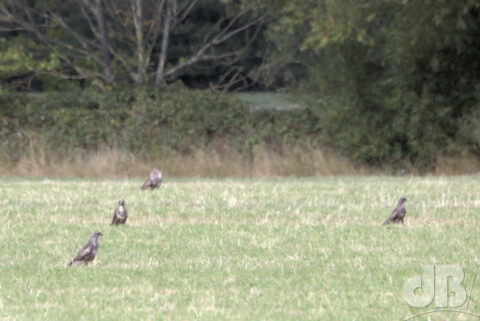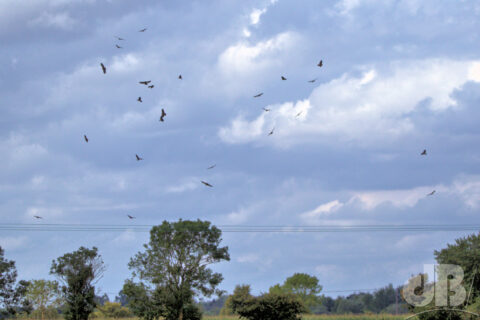TL:DR – There was a sudden influx of more than 100 Common Buzzards (Buteo buteo) on farmland after the hay was cut and baled. This species is a type of hawk, not a vulture.
When you get wind of something unusual in the birding world, the temptation is often to head for the site as quickly as possible binoculars slung around your neck and camera in the rucksack on your back. It’s often not the best strategy, birds fly and even if you think you’re being quick off the mark, often the update you saw may be out of date within minutes or hours of it being posted.

So, when I heard there was a large number of Common Buzzard* (Buteo buteo) gathered in a field not 20 minutes’ drive from home, I didn’t jump into the car and slam the pedal to the metal. I waiting until the next update to see how things might be changing over the hours from the first sighting to the next.

The initial report had said there were some 56 Buzzards in a field where the farmer was moving hay bales. The rodent population would have been on the run and it was presumably this that drew the avian crowd, which was apparently joined by a Marsh Harrier, Kestrel, and several Grey Herons. There were several more Buzzards in the adjacent field, apparently. This is an unprecedented number of this species in Cambridgeshire, a county record. Usually, they seem quite solitary and might gather in thermal-circling groups of three or four.

Most I’ve ever seen in one place was directly above our house when there were six riding ever upwards on the thermals. More than sixty in one place seemed bizarre…something you might see in some remote Eastern European valley or flying over Gibraltar Point, perhaps.
Anyway, I still didn’t dash. I was dithering. Worrying about the spiralling cost of diesel, for one thing, but also with the thought that by the time I get to this distant field, Sod’s law would dictate that they would have all departed. The next report came in and said there were perhaps eighty, the one after that told of at least 100 and maybe more in the trees and the fields beyond. So, with a rather pessimistic hat on and in no great rush, I made a coffee in a travel mug, grabbed my camera and binoculars, and headed for the fens.

I pulled up in a layby at the grid reference where all the reports said the Buzzards were to be seen. Pulling on the handbrake I glanced across the fields, they look bare but for grass slowly recovering after successive heatwaves. But for a Kestrel faffing with a vole and a couple of Black-headed Gulls, there seemed not to be much in what had temporarily been Buzzard country…
Not wanting to give in to the disappointment, I got out of the car and focused the binoculars into the middle distance, about 150 to 200 metres, I’d say. First one, then two, three, four Buzzards popped into existence, scattered randomly across the field. As my eyes shifted gear from fenland driving mode to birding mode, I scanned the field and started a more singular count…I got to 26. 26 Common Buzzards, more than I’d ever seen in one place before.
Not bad, a nice number. It was at this point that I trained the bins a little farther into the agricultural distance and realised the field behind and the one to the side had a lot more Buzzards than the nearest. I counted seventy for sure before a flock of them took to the air from the overhead wires, the trees and the hedgerows making a definitive total harder to count. It’s hard to know for sure, one report had indeed said there were 100+, I suspect I saw that many, maybe more this morning. On the other side of the road behind me the fields there had just two or three more Buzzards, another Kestrel, or perhaps the same one relocated, and a Red Kite overhead.
The Common Buzzard is, despite its name, is not particularly common, a few tens of thousands of breeding pairs in the UK. Much maligned and persecuted through ignorance like so many raptors (birds of prey) through the years, there was a time in recent history when you might live a country life and not see one. It’s a protected species now and no longer considered to be under any great threat from those that might have trapped and killed it in years past. The biggest threats today for the bird and pretty much every other species on earth is habitat loss, desertification, and climate change.
Anyway, I was glad a made the effort and used a splash of diesel to see this spectacle. I won’t reveal the location here for obvious reasons, but feel free to email me if you want to see them and wish the birds no harm. I cannot guarantee they’ll still be there by the time you read this, but you never know.
*American readers will be familiar with Buteo species but know them as hawks rather than buzzards. The term buzzard in American English is a colloquial term that oftens refers to the Turkey Vulture, Cathartes aura, which is related to the South American Condor rather than the vultures of Africa, or to the Black Vulture, Coragyps atratus.